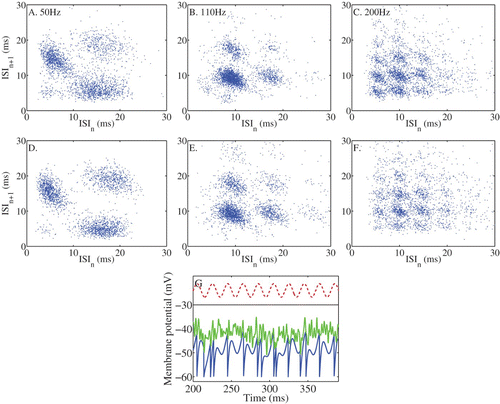Figures & data
Figure 1. The probability of firing in a model with Gaussian threshold noise. Here V th=−40 mV and σ=4 mV−1 (black), σ=3 mV−1 (red), σ=2 mV−1 (green), σ=1 mV−1 (blue) and σ=0.5 mV−1 (magenta).
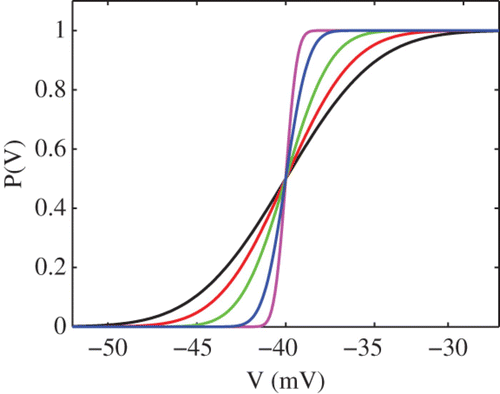
Figure 2. Loss of synchrony with increasing noise strength in a network of 1000 uncoupled leaky IF neurons for different values of the ratio of the driving frequency to the natural frequency of the neuron, sω ≡ ω/ω0, and the amplitude of forcing, a. Parameter values are (left) sω=1.1, a=1, (middle) sω=2.2, a=2, (right) sω=3.1, a=1.5. Other parameter values are η=2 ms, I 0=2.4, V L=V R=−60 mV, V th=−40 mV and τ=10 ms.

Figure 3. A plot of the amplitude of the population response function |δ r/δ I|/r 0 for a leaky integrator network as a function of sω≡ω/ω0 for σ=0.01 (black), σ=0.1 (green), σ=0.15 (blue), σ=0.2 (red) and σ=0.25 (magenta). The response function becomes progressively flatter and resonances are abolished as the blow up around sω=1 on the right illustrates. Other parameter values are V L=V R=−60 mV, V th=−40 mV, τ=10 ms and I 0=2.3.
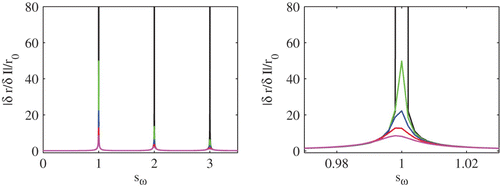
Figure 4. Network rate r (dots) for σ=0.001 mV (left) and σ=5.5 mV (right) in the 1:1 case for sω=1.1 and a=1. The solid black line in the right panel corresponds to the oscillating input signal. Other parameter values are η=2 ms, I 0=2.4, V L=V R=−60 mV, V th=−40 mV and τ=10 ms.
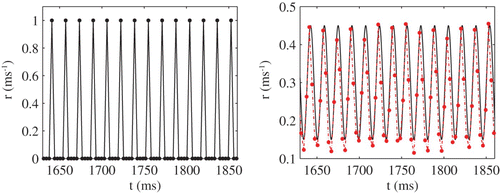
Figure 5. Left: Membrane potential (solid black line) and threshold (dotted black line) for different sinusoidal drive. Right: ISI distribution corresponding to the trajectories on the left; analytical results (solid black line) and histograms from direct numerical simulations (grey bars). Parameter values are from top to bottom η=2 ms, σ=0.2, sω=1.2, a=1, I 0=2.3; η=2 ms, σ=0.2, sω=2.2, a=2, I 0=2.3; η=2 ms, σ=0.1, sω=1.2, a=1, I 0=2.3; η=2 ms, σ=0.2, sω=1.2, a=1, I 0=2.4. Other parameter values are V L=V R=−60 mV, V th=−40 mV and τ=10 ms.
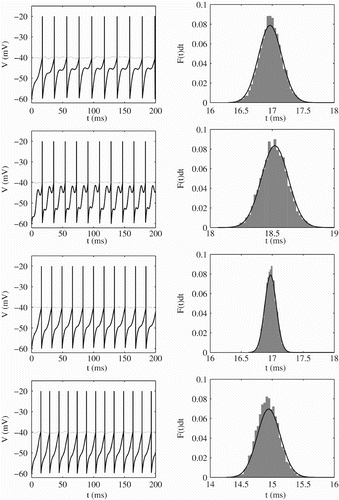
Figure 6. ISI distribution for different noise strengths: σ=0.1 (top left), σ=0.5 (top right), σ=1 (bottom left), σ=2 (bottom right). The deterministic dynamics shows a 1:4 mode-locked state. Other parameter values are η=2 ms, sω=4.1, a v =2.25, I 0=2.4, V L=V R=−60 mV, V th=−40 mV and τ=10 ms.

Figure 7. ISI distribution when the deterministic dynamics shows a 2:1 mode-locked state. Parameter values are σ=0.5, sω=0.5, a=1, η=2 ms, I 0=2.4, V L=V R=−60 mV, V th=−40 mV and τ=10 ms.
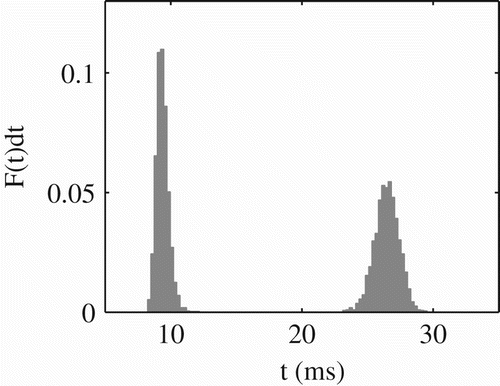
Figure 8. Plots of the Liapunov exponent in the (a, sω) plane showing Arnol'd tongues for σ=0, 0.5, 1, 1.5, 2, 2.5 parameter values are η=2 ms, I 0=2.3, V L=V R=−60 mV, V th=−40 mV and τ=10 ms.
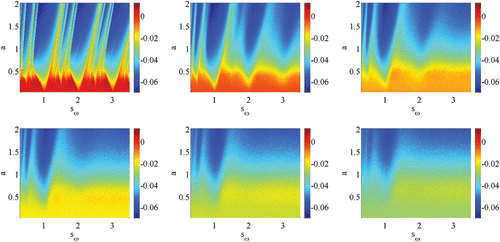
Figure 9. A-C. ISI scattergrams of the responses of a VCN chopper unit to amplitude modulated tones. The tone was 3 s long, with a frequency the same as the characteristic frequency of the unit, 50 dB above the CF threshold. AM depth was 100% and frequency was as indicated. D-F. The responses of a stochastic-threshold IF model fitted to the data. The model parameters were: sinuisodal input: a=0.7, I 0=1.5 mV, threshold noise: σ=2.7, η=0.75 ms, IF parameters: τ=3.18 ms, V L=V R=−60 mV, V th=−42 mV. G. An example of the evolution of the membrane potential of the model (blue) for the 50 Hz modulation rate, the stochastic threshold (green) and the modulated input on an arbitrary scale.
